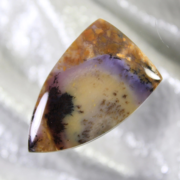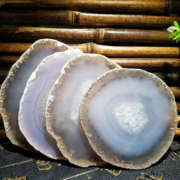Fire Agate
Fire agate is a unique and captivating variety of chalcedony, renowned for its mesmerizing display of iridescent colors reminiscent of flickering flames. This gemstone is highly valued for its striking appearance and metaphysical properties, making it a sought-after choice among collectors and enthusiasts.

Fire agate forms within cavities or vesicles in volcanic rocks, typically basalt. It derives its vivid colors from the thin layers of iron oxide and other mineral impurities deposited within the rock cavities over millions of years. The mesmerizing play of light and color is caused by the interference and diffraction of light as it passes through these layers, creating a stunning visual effect reminiscent of flames dancing on the surface.
The history of fire agate traces back to ancient times when it was prized by indigenous cultures for its believed mystical properties. It was often used for spiritual ceremonies and rituals, with some cultures associating it with protection and vitality. However, its popularity in the modern gemstone market has surged in recent decades, particularly among jewelry designers and collectors drawn to its unique beauty.
Fire agate is primarily found in Mexico, particularly in the states of Chihuahua, Durango, and San Luis Potosí. However, smaller deposits have also been discovered in the southwestern United States, including Arizona and California.
Overall, fire agate’s exquisite beauty and intriguing formation process have made it a cherished gemstone with a rich history and enduring allure in the world of gemstone enthusiasts and collectors.
Contents
- Geological Formation
- Physical Properties
- Occurrence and Mining Locations
- Uses and Applications
Geological Formation

Fire agate forms through a process known as “chalcedony replacement.” Here’s a breakdown of the geological formation:
- Volcanic Activity: The process begins with volcanic activity, where molten rock (magma) rises from the Earth’s mantle towards the surface. As the magma cools and solidifies, it forms volcanic rocks like basalt.
- Formation of Voids: Within these volcanic rocks, gas bubbles or cavities (known as vesicles) can form as a result of gases trapped in the magma during the eruption. These cavities vary in size and shape and provide the ideal conditions for the formation of fire agate.
- Silica-Rich Solutions: Over time, silica-rich solutions, often containing dissolved minerals such as iron oxide and manganese oxide, percolate through the porous volcanic rock. These solutions may come from hydrothermal fluids or groundwater.
- Deposition of Minerals: As the silica-rich solutions flow through the cavities, they deposit thin layers of silica (chalcedony) along the cavity walls. These layers gradually build up over time, creating the characteristic banded structure of fire agate.
- Formation of Iridescence: The brilliant iridescent colors of fire agate are produced by the interference and diffraction of light as it passes through the thin layers of silica and mineral impurities. This phenomenon is similar to the way colors are produced in opal and other gemstones with play-of-color.
- Further Mineralization: In some cases, additional mineralization can occur within the silica layers, contributing to the variety of colors and patterns observed in fire agate.
This geological process is relatively slow, taking place over millions of years. The unique combination of volcanic activity, cavity formation, and mineral deposition results in the formation of these captivating gemstones with their fiery, iridescent appearance.
Physical Properties

Fire agate possesses several physical properties that contribute to its unique appearance and characteristics:
- Color: The most distinctive feature of fire agate is its iridescent play-of-color, which resembles flickering flames. These colors typically include vibrant reds, oranges, yellows, and sometimes greens and blues. The iridescence is caused by the interference and diffraction of light as it interacts with the thin layers of silica and mineral impurities within the gemstone.
- Transparency: Fire agate is typically translucent to opaque, with varying degrees of transparency depending on the quality of the specimen. The translucent nature allows light to penetrate the gemstone, enhancing its play-of-color.
- Hardness: On the Mohs scale of mineral hardness, fire agate has a hardness of around 6.5 to 7. This makes it relatively durable and suitable for use in jewelry, though care should still be taken to prevent scratching or chipping.
- Luster: Fire agate exhibits a vitreous to waxy luster when polished, giving it a smooth and glossy appearance.
- Crystal Structure: Fire agate belongs to the chalcedony family, which is a type of microcrystalline quartz. It typically forms in cryptocrystalline aggregates, meaning its crystals are too small to be seen without magnification.
- Cleavage and Fracture: Fire agate lacks cleavage, meaning it does not break along specific planes like some minerals. Instead, it typically displays conchoidal fracture, producing smooth, curved surfaces when broken.
- Specific Gravity: The specific gravity of fire agate varies depending on its composition and porosity but generally ranges from 2.58 to 2.64. This property can help distinguish it from other gemstones with similar appearances.
These physical properties contribute to the overall beauty and allure of fire agate, making it a prized gemstone for jewelry and decorative purposes.
Occurrence and Mining Locations

Fire agate is primarily found in specific geological settings, particularly in regions with volcanic activity and the presence of silica-rich solutions. The most notable occurrence of fire agate is in Mexico, although smaller deposits exist in other parts of the world. Some of the main mining locations include:
- Mexico: Mexico is renowned for its significant deposits of fire agate, particularly in the states of Chihuahua, Durango, and San Luis Potosí. These regions have been the primary source of high-quality fire agate specimens for many years.
- United States: In the United States, fire agate has been found in several states, with Arizona and California being the most notable. In Arizona, fire agate is primarily found in the Slaughter Mountain area near Globe, as well as in the Deer Creek and Round Mountain regions. In California, fire agate has been discovered in areas such as the Hauser Geode Beds in Riverside County.
- Other Locations: While Mexico and the United States are the primary sources of fire agate, smaller deposits have also been found in other countries, including Brazil, India, and Australia. However, these occurrences are less significant compared to those in Mexico and the United States.
Mining for fire agate typically involves searching for deposits within volcanic rock formations, particularly in areas where the conditions for its formation are favorable. Miners may extract fire agate through various methods, including surface mining and underground mining, depending on the specific geological characteristics of the deposit.
Overall, fire agate remains a relatively rare and prized gemstone, with mining operations focused primarily in regions known for their abundant deposits of this captivating gem.
Uses and Applications

Fire agate is primarily valued for its beauty and unique visual appeal, making it a sought-after gemstone for use in jewelry and decorative objects. Some of its main uses and applications include:
- Jewelry: Fire agate is commonly used in jewelry design, where it is fashioned into various pieces such as rings, pendants, earrings, and bracelets. Its vibrant colors and iridescent play-of-color make it an eye-catching choice for both artisan and commercial jewelry makers.
- Carvings and Cabochons: Fire agate’s distinctive patterns and colors make it popular for use in carved gemstone sculptures and cabochons. Artisans may create intricate carvings or polished cabochons to showcase the gemstone’s natural beauty.
- Collectibles: Fire agate specimens with exceptional color play and clarity are highly prized by collectors and enthusiasts. Collectors may seek out rare and unique specimens to add to their gemstone collections.
- Metaphysical and Spiritual Practices: In some spiritual and metaphysical traditions, fire agate is believed to possess various healing and protective properties. It is often used for meditation, energy work, and balancing the body’s energy centers (chakras).
- Lapidary Art: Fire agate is also used by lapidary artists for inlay work, intarsia, and other forms of gemstone artistry. Its hardness and durability make it suitable for use in a variety of lapidary techniques.
- Decorative Objects: Fire agate may be incorporated into decorative objects such as sculptures, vases, and ornamental pieces. Its striking appearance adds visual interest and sophistication to any decorative setting.
Overall, fire agate’s versatility and aesthetic appeal make it a prized gemstone with diverse applications in jewelry, art, and spirituality. Whether worn as a stunning piece of jewelry or displayed as a collectible specimen, fire agate continues to captivate admirers with its fiery beauty.





Leave a Reply
Want to join the discussion?Feel free to contribute!